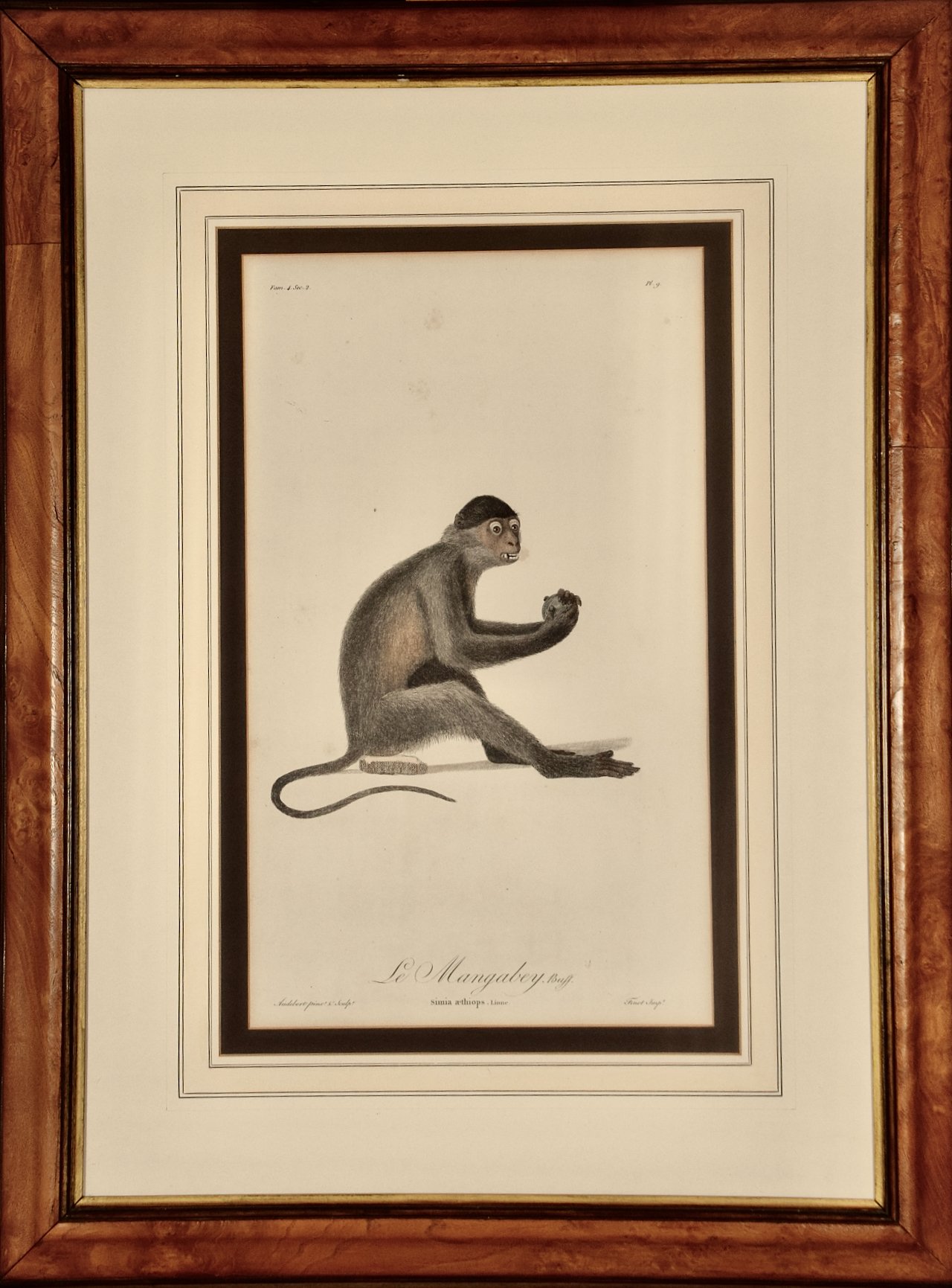Le Mangabey Monkey: Framed Audebert 18th C. Hand-colored Engraving
This is a framed 18th century folio-sized colored stipple engraving with hand-finishing entitled "Le Mangabey, Buff, Simia Aethiops, Linne", which was drawn and engraved by Jean Baptiste Audebert. It appeared as plate 5 in Audebert's 'Histoire Naturelle des Singes et des Makis Peintres d’après Nature' (Natural History of Monkeys and Lemurs), published in Paris in 1797. It depicts a Mangabey Monkey sitting and facing right. It is holding an object in both hands, perhaps a large nut. This Mangabey belongs to the genus Cercocebus. They are characterized by their bare upper eyelids and their fairly uniform coloring of their fur. These large monkeys live mainly in forests and are found only in Africa. Mangabeys are some of the most rare and endangered monkeys on Earth.
Creator: Jean Baptiste Auderbert (1759 - 1800, French)
Creation Year: 1797
Dimensions: Height: 30.5 in (77.47 cm) Width: 23.25 in (59.06 cm) Depth: 2 in (5.08 cm)
Medium: Engraving
Condition: See description below.
Reference #: 4833
This is a framed 18th century folio-sized colored stipple engraving with hand-finishing entitled "Le Mangabey, Buff, Simia Aethiops, Linne", which was drawn and engraved by Jean Baptiste Audebert. It appeared as plate 5 in Audebert's 'Histoire Naturelle des Singes et des Makis Peintres d’après Nature' (Natural History of Monkeys and Lemurs), published in Paris in 1797. It depicts a Mangabey Monkey sitting and facing right. It is holding an object in both hands, perhaps a large nut. This Mangabey belongs to the genus Cercocebus. They are characterized by their bare upper eyelids and their fairly uniform coloring of their fur. These large monkeys live mainly in forests and are found only in Africa. Mangabeys are some of the most rare and endangered monkeys on Earth.
Creator: Jean Baptiste Auderbert (1759 - 1800, French)
Creation Year: 1797
Dimensions: Height: 30.5 in (77.47 cm) Width: 23.25 in (59.06 cm) Depth: 2 in (5.08 cm)
Medium: Engraving
Condition: See description below.
Reference #: 4833
This is a framed 18th century folio-sized colored stipple engraving with hand-finishing entitled "Le Mangabey, Buff, Simia Aethiops, Linne", which was drawn and engraved by Jean Baptiste Audebert. It appeared as plate 5 in Audebert's 'Histoire Naturelle des Singes et des Makis Peintres d’après Nature' (Natural History of Monkeys and Lemurs), published in Paris in 1797. It depicts a Mangabey Monkey sitting and facing right. It is holding an object in both hands, perhaps a large nut. This Mangabey belongs to the genus Cercocebus. They are characterized by their bare upper eyelids and their fairly uniform coloring of their fur. These large monkeys live mainly in forests and are found only in Africa. Mangabeys are some of the most rare and endangered monkeys on Earth.
Creator: Jean Baptiste Auderbert (1759 - 1800, French)
Creation Year: 1797
Dimensions: Height: 30.5 in (77.47 cm) Width: 23.25 in (59.06 cm) Depth: 2 in (5.08 cm)
Medium: Engraving
Condition: See description below.
Reference #: 4833
This original 18th century colored stipple engraving with hand-finishing creates the appearance of a watercolor. The technique was created by French botanical artist Pierre-Joseph Redouté, with some contributions by Audebert. The print is presented in a beautiful natural burlwood frame with black outer trim and black and gold inner trims. There is a cream-colored outer French mat with a pale yellow highlight band and a taupe-colored inner mat. The frame measures 30.5" high by 23.25" wide and 2" deep. There are a few faint spots, but the print and frame are otherwise in excellent condition.
This engraving is part of a set of eleven framed portraits of monkeys from Audebert's publication that are available for purchase. Several of these would make a striking display grouping.
The set was owned by Patricia Moffat Pope (Patsy) (1927-2020). She was a cattleman's daughter, who grew up with horses, eventually building a thoroughbred horse racing empire with her husband George A. Pope, Jr. Their horses won 27 stakes races in the United States and in Europe, including the 1962 Kentucky Derby with Decidedly, the 1964 Santa Anita Derby with Hill Rise, the 1000 Guineas and the Epsom Oaks with Mysterious in 1973 in England and they handed the famous Seattle Slew his first defeat in 1977 with J.O. Tobin in the Swaps Stakes at Hollywood Park. Her husband called her "the Rose of the Ranch" so she planted hundreds of rose bushes and often brought big bouquets of flowers to her friends and family. She was a patron of the arts and sciences.
Jean Baptiste Audebert (1759-1800) was a French artist and naturalist. He studied painting and drawing in Paris and began his art career as a miniature painter, but soon pivoted to the natural sciences. His first publication, 'Histoire naturelle des singes' (The Natural History of monkeys) was published in 1800, which contained 62-63 folio-sized plates that he drew and engraved. He used a new unique technique for these illustrations that he originated. He died young, shortly after the publication of this work. He was working on other manuscripts, which were published posthumously. The popular 'Relation du Voyage à la Recherche de la Pérouse' (Account of the Voyage in Search of la Perouse) focussed on the mysterious disappearance of the great French explorer Jean François Galaup de La Pérouse and the search for his ship. Two other posthumous publications were 'Histoire des colibris, oiseaux-mouches, jacamars et promerops' (History of hummingbirds, jacamars and promerops) and 'L'Histoire des grimpereaux et des oiseaux de paradis' (The History of Creepers and Birds of Paradise).































